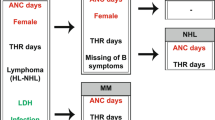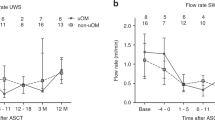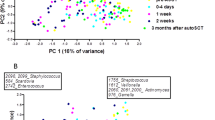Abstract
Mucositis is a common and vexing complication of autologous progenitor cell transplantation (ABMT). A modified oral mucositis assessment scale (OMAS) has been found to be a reproducible and effective tool for monitoring mucositis after radiation therapy or chemotherapy. We utilized the modified OMAS scale to study clinical parameters associated with the development of mucositis in 79 patients undergoing ABMT. Median patient age was 52; 61% had non-Hodgkin's lymphoma (NHL), 23% multiple myeloma and 14% Hodgkin's disease. Patients were mobilized with G-CSF alone or the combination of etoposide plus G-CSF. Univariable correlates of worse mucositis were prior radiation therapy (P = 0.004), a diagnosis of NHL (P = 0.014), progenitor cell mobilizing regimen containing etoposide (P = 0.001), and ABMT preparative regimen containing etoposide (P = 0.006). Multivariable regression analysis revealed that NHL diagnosis (P = 0.007), prior radiation therapy (P = 0.001), and etoposide in the mobilizing regimen (P = 0.034) were associated with worse post-transplant mucositis. Worsening mucositis correlated with a longer inpatient length of stay. We conclude that several variables contribute to worsening mucositis during autologous transplantation, including etoposide in the progenitor cell mobilizing regimen.
This is a preview of subscription content, access via your institution
Access options
Subscribe to this journal
Receive 12 print issues and online access
$259.00 per year
only $21.58 per issue
Buy this article
- Purchase on Springer Link
- Instant access to full article PDF
Prices may be subject to local taxes which are calculated during checkout

Similar content being viewed by others
References
Sonis S, Oster G, Fuchs H et al. Oral mucositis and the clinical and economic outcomes of hematopoietic stem-cell transplantation J Clin Oncol 2001 19: 2201 2205
Rapoport A, Watelet L, Linder T et al. Analysis of factors that correlate with mucositis in recipients of autologous and allogeneic stem-cell transplants J Clin Oncol 1999 17: 2446 2453
Wardley A, Jayson G, Swindell R et al. Prospective evaluation of oral mucositis in patients receiving myeloablative conditioning regimens and haemopoietic progenitor rescue Br J Haematol 2000 110: 292 299
Pillitteri LC, Clark RE . Comparison of a patient-controlled analgesia system with continuous infusion for administration of diamorphine for mucositis Bone Marrow Transplant 1998 22: 495 498
Sonis S, Eilers J, Epstein J et al. Validation of a new scoring system for the assessment of clinical trial research of oral mucositis induced by radiation or chemotherapy Cancer 1999 85: 2103 2113
Reiser M, Josting A, Draube A et al. Successful peripheral blood stem cell mobilization with etoposide (VP-16) in patients with relapsed or resistant lymphoma who failed cyclophosphamide mobilization Bone Marrow Transplant 1999 23: 1223 1228
Kanfer EJ, McGuigan D, Samson D et al. High-dose etoposide with granulocyte colony-stimulating factor for mobilization of peripheral blood progenitor cells: efficacy and toxicity at three dose levels Br J Cancer 1998 78: 928 932
Copelan E, Caselski S, Ezzone S et al. Mobilization of peripheral-blood progenitor cells with high-dose etoposide and granulocyte colony-stimulating factor in patients with breast cancer, non-Hodgkin's lymphoma, and Hodgkin's disease J Clin Oncol 1997 15: 759 765
Soni N, Meropol N, Pendyala L et al. Phase I and pharmacokinetic study of etoposide phosphate by protracted venous infusion in patients with advanced cancer J Clin Oncol 1997 15: 766 772
Postmus P, Mulder N, Sleijfer D et al. High-dose etoposide for refractory malignancies: a phase I study Cancer Treatment Rep 1984 68: 1471 1474
Copelan E, Penza S, Pohlman B et al. Autotransplantation following busulfan, etoposide and cyclophosphamide in patients with non-Hodgkin's lymphoma Bone Marrow Transplant 2000 25: 1243 1248
Kröger N, Hoffknecht M, Hänel M et al. Busulfan, cyclophosphamide and etoposide as high-dose conditioning therapy in patients with malignant lymphoma and prior dose-limiting radiation therapy Bone Marrow Transplant 1998 21: 1171 1175
Zander A, Berger C, Kröger N et al. High dose chemotherapy with busulfan, cyclophosphamide, and etoposide as conditioning regimen for allogeneic bone marrow transplantation for patients with acute myeloid leukemia in first complete remission Clin Cancer Res 1997 3: 2671 2675
Argiris A, Seropian S, Cooper D . High-dose BEAM chemotherapy with autologous peripheral blood progenitor-cell transplantation for unselected patients with primary refractory or relapsed Hodgkin's disease Ann Oncol 2000 11: 665 672
Chao N, Stein A, Long G et al. Busulfan/etoposide-initial experience with a new preparatory regimen for autologous bone marrow transplantation in patients with acute nonlymphoblastic leukemia Blood 1993 81: 319 323
Postmus P, De Vries G, De Vries-Hospers H et al. Cyclophosphamide and VP 16-213 with autologous bone marrow transplantation. A dose escalation study Eur J Cancer Clin Oncol 1984 20: 777 782
Wolff S, Fer M, McKay C et al. High-dose VP-16-213 and autologous bone marrow transplantation for refractory malignancy: a phase I study J Clin Oncol 1983 1: 701 705
Oblon DJ, Paul SR, Oblon MB et al. Propantheline protects the oral mucosa after high-dose ifosfamide, carboplatin, etoposide and autologous stem cell transplantation Bone Marrow Transplant 1997 20: 961 963
Duenas-Gonzalez A, Sobrevilla-Calvo P, Frias-Mendivil M et al. Misoprostol prophylaxis for high-dose chemotherapy-induced mucositis: a randomized double-blind study Bone Marrow Transplant 1996 17: 809 812
Epstein JB, Vickars L, Spinelli et al. Efficacy of chlorhexidine and nystatin rinses in prevention of oral complications in leukemia and bone marrow transplantation Oral Surg Oral Med Oral Pathol 1992 73: 682 689
Rutkauskas JS, Davis JW . Effects of chlorhexidine during immunosuppressive chemotherapy. A preliminary report Oral Surg Oral Med Oral Pathol 1993 76: 441 448
Foote RL, Loprinzi CL, Frank AR et al. Randomized trial of a chlorhexidine mouthwash for alleviation of radiation-induced mucositis J Clin Oncol 1994 12: 2630 2633
Vesole D, Fuchs H . IB-367 Reduces the number of days of severe oral mucositis complicating myeloablative chemotherapy Blood 1999 94: Abstr 675
Martin PJ, Hurd DD, Miller TR et al. A phase III randomized, placebo-controlled, double-blind, multinational study (RCDBM) of protegrin IB-67 rinse in reducing the incidence of ulcerative oral mucositis (OM) in patients (Pts) receiving stomatoxic chemotherapy (PROMPT-CT trial) Thirty-Seventh Ann Proc ASCO, May 2001 Abstr 1551
Speilberger RT, Stiff P, Emmanouilides C et al. Efficacy of recombinant human keratinocyte growth factor (rHuKGF) in reducing mucositis in patients with hematologic malignancies undergoing autologous peripheral blood progenitor cell transplantation (auto-PBPCT) after radiation-based conditioning: results of a phase 2 trial Thirty-Seventh Ann Proc ASCO, May 2001 Abstr 25
Author information
Authors and Affiliations
Rights and permissions
About this article
Cite this article
Bolwell, B., Kalaycio, M., Sobecks, R. et al. A multivariable analysis of factors influencing mucositis after autologous progenitor cell transplantation. Bone Marrow Transplant 30, 587–591 (2002). https://doi.org/10.1038/sj.bmt.1703694
Received:
Accepted:
Published:
Issue Date:
DOI: https://doi.org/10.1038/sj.bmt.1703694
Keywords
This article is cited by
-
Prospective longitudinal analysis of clinical and immunological risk factors associated with oral and gastrointestinal mucositis following autologous stem cell transplant in adults
Supportive Care in Cancer (2023)
-
Prediction of mucositis risk secondary to cancer therapy: a systematic review of current evidence and call to action
Supportive Care in Cancer (2020)
-
New photobiomodulation protocol prevents oral mucositis in hematopoietic stem cell transplantation recipients—a retrospective study
Lasers in Medical Science (2017)
-
Cyclosporine Plus Methotrexate or Cyclosporine Plus Mycophenolate Mofetil as Graft Versus Host Disease Prophylaxis in Acute Leukemia Transplant: Comparison of Toxicity, Engraftment Kinetics and Transplant Outcome
Indian Journal of Hematology and Blood Transfusion (2016)
-
LACE versus BEAM conditioning in relapsed and refractory lymphoma transplant: retrospective multicenter analysis of toxicity and efficacy
International Journal of Hematology (2016)



